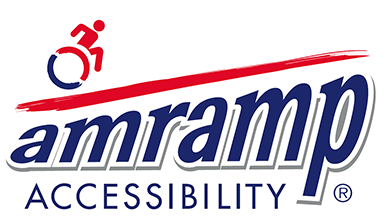Choosing a wheelchair ramp for your home is not an easy task. There are many variables to address when determining how to make your home accessible and safe when mobility becomes compromised. So how do you decide what you need?
Here are some questions that will help you make the best choice:
- Is the person using a wheelchair, walker, cane or just struggling with steps?
- Is the situation permanent or temporary?
- How many steps are at the main entrance?
- Are there thresholds that are tripping hazards?
- Is it difficult to access the deck, porch or patio?
There are 4 main types of ramps: Threshold, Portable, Permanent, and Modular.
Threshold Ramps – for heights of ¾” up to 6”, usually aluminum or rubber, great for doorway entrances.
Portable Ramps – great for 1-2 steps, come in lengths from 2’ to 10’, easily moved when not in use, however they do not have railings.
Concrete and Wood Ramps – permanent ramps that require proper design, installation permits and a contractor. Delivery & installation usually takes the most time.
Modular Ramps – made from steel or aluminum and can be designed for most home situations. They come in various sizes and widths, with railings and platforms. They are RENTABLE and can be installed on a temporary basis.
The Americans with Disabilities Act (ADA) sets guidelines for safe wheelchair ramps. According to the ADA, a slope should measure 1 foot of length for every inch of rise. For example, if you have 3 stairs at the front entrance that are each 7 inches high, the wheelchair ramp should be at least 21 feet long. Proper railings are another safety feature. Ramps over 6 feet long or 6 inches high must have handrails. A platform at the door provides a level surface and should extend at least 2 feet beyond the door to allow the door to swing open and provide a safe level space for someone in a wheelchair to open or close the door and turn around.

When considering a wheelchair ramp, it’s important to ask the following questions:
There are several basic design features that every ramp needs.
- You need a landing outside the door that is large enough to accommodate the swing of the door and room to spare for the wheelchair.
- You need rails all around to prevent the chair from running over the edge.
- You need to use a safe degree of slope. The standard slope for the ramp is 1 in 12. That is, for every 1” vertical, you need 12” of horizontal travel.
The 1 in 12 slope rule is not set in stone. It is an ADA (American Disabilities Act) requirement for all public facilities. But it does not apply to residential buildings. Still, it is a good safe rule to follow and it’s possible that the city you live in has adopted it as code for your area. Check with your city before you start. In the end, what’s important is that the slope is not too steep to provide for the safe and easy use by the wheelchair user.
There are pros and cons for steel, wood and metal wheelchair ramps.
Here are a few things to consider:
What about cost?
Steel is almost always the lowest in cost. Wood can be the lowest if the labor is donated or provided by a family member. Wood is the highest in cost if the labor is done by a contractor.
WOOD | STEEL | CONCRETE | ALUMINUM |
| Lowest or Highest | Lowest | Highest | Medium |
What about maintenance?
Concrete and Aluminum wheelchair ramps are best for maintenance. Some touch-up is occasionally required. Wood needs to be regularly treated with a wood sealer.
WOOD | STEEL | CONCRETE | ALUMINUM |
| High | Low | Low | Low |
What about safety?
Wood rots. Wood, concrete and aluminum wheelchair ramps all have solid surfaces that allow moisture to accumulate and freeze, creating a dangerous ice film. Steel wheelchair ramps have a gripping texture that prevents skidding. Steel wheelchair ramps also have an open-pattern ramp surface that allows moisture to pass through, eliminating the danger of ice film. Steel and concrete are fireproof. Wood and aluminum cannot withstand the heat of a fire.
WOOD | STEEL | CONCRETE | ALUMINUM |
| Worst | Best | Worst | Worst |
What about rentals?
About 45% of wheelchair ramps should be rented when they are not needed permanently. Wheelchair ramp rentals are convenient for short term disabilities, recovery from surgery or special events such as weddings, graduations or family gatherings, with no minimum time or amount of ramp required.
WOOD | STEEL | CONCRETE | ALUMINUM |
| No | Yes | No | Maybe |
What about durability?
Steel is three times stronger than aluminum, and can withstand both fires and hurricanes.
WOOD | STEEL | CONCRETE | ALUMINUM |
| Worst | Best | Best | Medium |
What about proper ramp design?
Carpenters and family members have limited knowledge of what is a safe and ADA-compliant wheelchair ramp. Aluminum wheelchair ramps are not measured or installed by the manufacturing personnel. Steel wheelchair ramps, on the other hand, include a free evaluation by the wheelchair ramp manufacturer’s expert, who is based in your community.
WOOD | STEEL | CONCRETE | ALUMINUM |
| No | Yes | No | No |
What about appearance?
Depending on the property, wood wheelchair ramps can match an existing deck; steel wheelchair ramps can look like wrought iron; concrete wheelchair ramps can match a walkway. Aluminum wheelchair ramps are shiny and commercial-looking – not suitable for residential applications.
WOOD | STEEL | CONCRETE | ALUMINUM |
| No | Yes | Yes | No |
What about moving or changing my wheelchair ramps after purchase?
If you move, you can take all or part of your steel wheelchair ramp or aluminum wheelchair ramp with you, and add to it or shorten it as necessary. If your needs in terms of equipment or caregiver change, the steel wheelchair ramp or aluminum wheelchair ramp can be corrected to the new situation. If you find the wood wheelchair ramp or concrete wheelchair ramp is too steep after you buy it, no correction is possible.
WOOD | STEEL | CONCRETE | ALUMINUM |
| No | Yes | No | Yes |
What about the possible resale value of the wheelchair ramp?
There is a market for used steel wheelchair ramps and aluminum wheelchair ramps when you no longer need them.
WOOD | STEEL | CONCRETE | ALUMINUM |
| No | Yes | No | Yes |
What about availability?
Because steel wheelchair ramps and aluminum wheelchair ramps are delivered from pre-manufactured stock, you can get these wheelchair ramps in days. Wood or concrete wheelchair ramp availability depends on a contractor’s responsiveness.
WOOD | STEEL | CONCRETE | ALUMINUM |
| Worst | Best | Worst | Medium |
What about the excavation of property?
Concrete frost footings are required for wood wheelchair ramps. As frost heaves and concrete settles, these rigid structures will become damaged and misaligned. Steel wheelchair ramps and aluminum wheelchair ramps are easily realigned, as they are designed with adjustable support structures. Steel wheelchair ramp adjustments are done free for the life of the original wheelchair ramp installation.
WOOD | STEEL | CONCRETE | ALUMINUM |
| Yes | No | Yes | No |
What about the possible devaluation of property?
Upon resale, wheelchair ramps will bring down the value of the home, as only one out of 200 people uses a wheelchair. There are significant costs to digging up and disposing of wood and concrete wheelchair ramps and their footings.
WOOD | STEEL | CONCRETE | ALUMINUM |
| Worst | Best | Worst | Best |
What about building permits?
Wood and concrete wheelchair ramps are permanent modifications to the home, requiring permits. Steel and aluminum modular wheelchair ramps are classified as reusable durable medical equipment (DME) and do not usually require permits.
WOOD | STEEL | CONCRETE | ALUMINUM |
| Yes | No | Yes | No |
What about taxable revaluation of the property after the wheelchair ramp is installed?
The building permit process includes reassessment of the property after the permit is issued.
WOOD | STEEL | CONCRETE | ALUMINUM |
| Yes | No | Yes | No |
What about recycling?
Steel wheelchair ramps are made from 100% recycled steel and are 100% recyclable. Pressure-treated wood, used in wooden wheelchair ramps, contains dangerous chemicals, cannot be reused and is not allowed in landfills.
WOOD | STEEL | CONCRETE | ALUMINUM |
| No | Yes | No | Yes |






